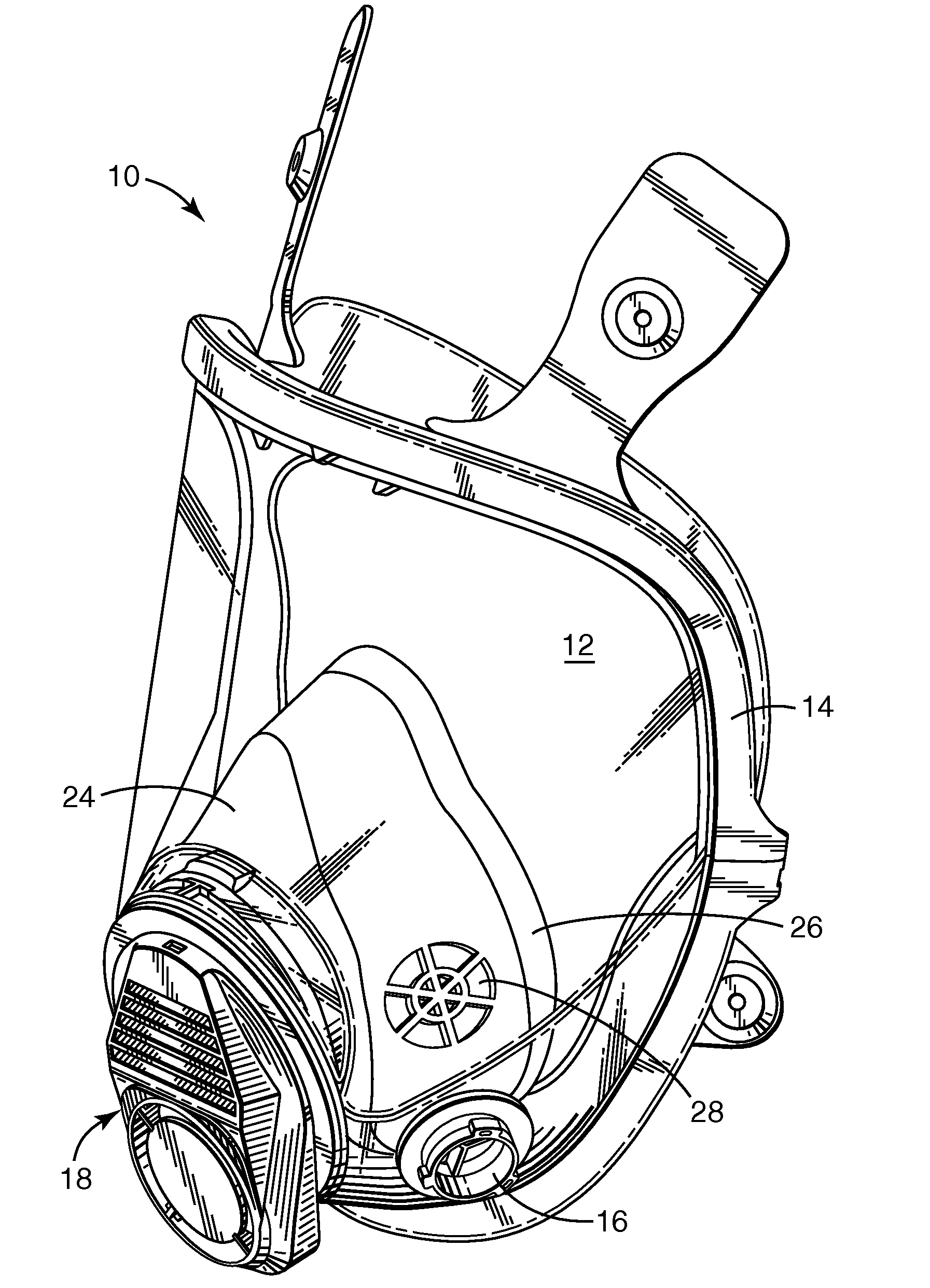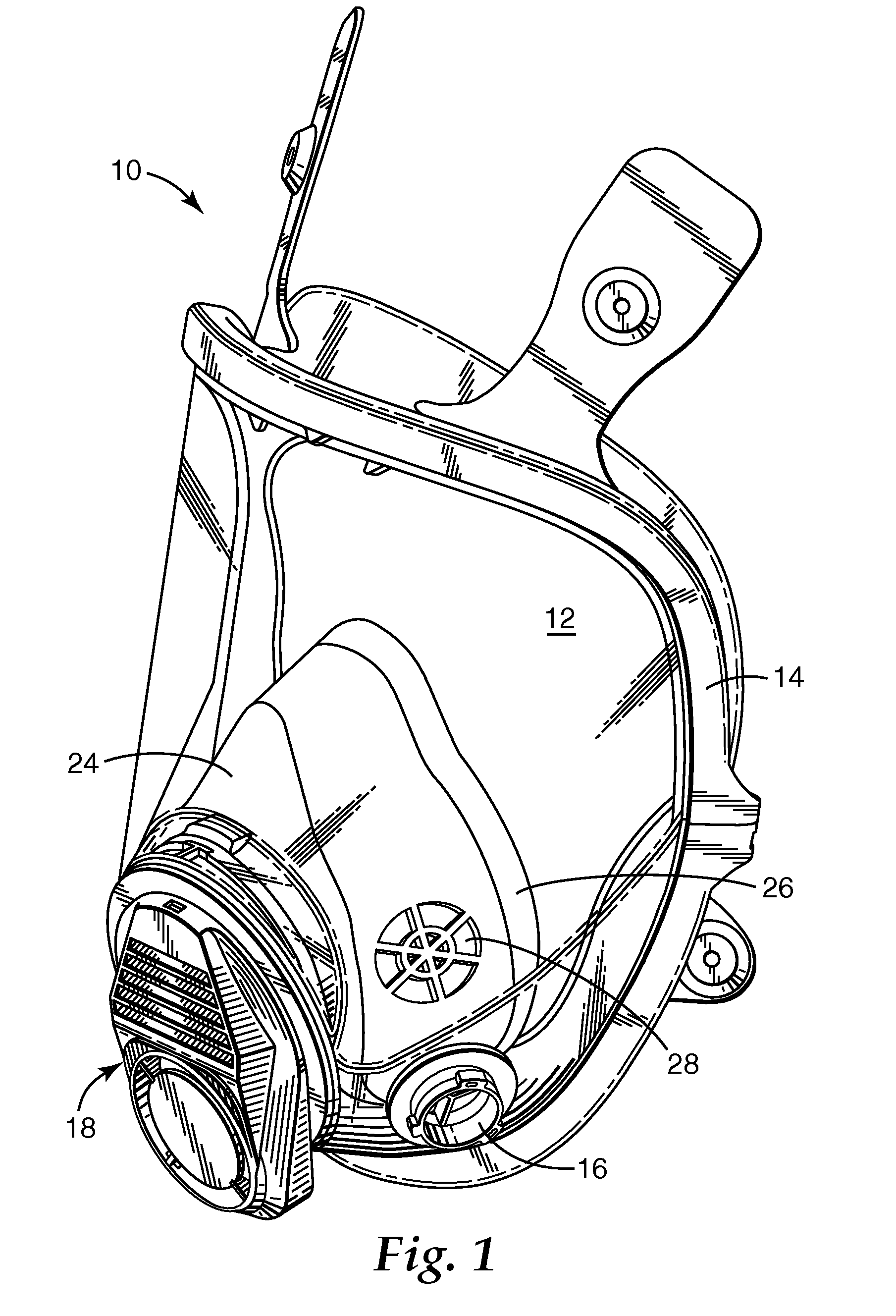Respirator, welding helmet, or face shield that has low surface energy hard-coat lens
a technology of hard coating and spherical shield, which is applied in the direction of breathing protection, polyether coating, chemical protection, etc., can solve the problems of obstructing the wearer's vision, easy scratching and fracture of polycarbonate lenses, and staining patterns that can obstruct the wearer's vision, etc., to achieve good scratching and chemical resistance, good stain resistance, and low surface energy
- Summary
- Abstract
- Description
- Claims
- Application Information
AI Technical Summary
Benefits of technology
Problems solved by technology
Method used
Image
Examples
examples
Test Methods
Nuclear Magnetic Resonance (NMR)
[0307]1H and 19F NMR spectra are run on a Varian UNITYplus 400 Fourier transform NMR spectrometer (available from Varian NMR Instruments, Palo Alto, Calif.).
IR Spectroscopy (IR)
[0308]IR spectra are run on a Thermo-Nicolet, Avatar 370 FTIR, obtainable from Thermo Electron Corporation, Waltham, Mass.
Ink Repellency Test
[0309]This test is used to measure the ink repellency of the coatings on polycarbonate plaques. Coated polycarbonate plaques are prepared as described above. A line is drawn across the surface of a coated polycarbonate plaque using a Sharpie marker (available from Sanford, Bellwood, Ill.). The samples are rated for appearance and for the ability to repel a black Sharpie marker.
Ink Repellency Test RatingsRankingDescription1Ink beaded intodiscretehemisphericaldroplets2Ink beaded intodiscrete elongateddroplets3Ink line narrowedand is discontinuous4Ink line iscontinuous and isnot narrowed
Ink Repellency Durability Test
[0310]A modifi...
preparation 5
[0346]30 g, 0.15 eq. isocyanate DESMODURN3300A, 40.3 g, 0.03 mol HFPO—C(O)N(H)CH2CH2OH, 43.8 g solution, 31 g, 0.12 mol pentaerythritol triallyl ether, and 445 g MIBK were charged into 1 L flask. The mixture was heated to 8° C. while stirring and a solution was formed. The solution was purged with N2 for 1 minute and three drops each of DBTDL and DABCO 33LV were added to it. The resulting solution was then heated to 110° C. for 15 hours. At the end of the 15 hours, the IR spectrum of a sample had no peaks corresponding to a NCO group. The solution was then allowed to cool to 70° C. and 70.7 g, 0.36 mol mercaptopropyltrimethoxysilane was then added. After the solution was purged with N2 for 3 minutes and 0.7 g VAZO 67 was added to it, the solution was heated for 16 hours at 70° C. Following this period, there were no allylic groups remaining as determined from IR spectrum of a sample. The product fluorochemical urethane silane was a golden solution with 28% solids content.
preparation 6
[0347]30 g, 0.15 eq isocyanate DESMODUR N3300A, 40.3 g, 0.03 mol HFPO—C(O)N(H)CH2CH2OH, 10.7 g, 0.03 mol MeFBSE, 33 g solution, 23 g, 0.09 mol pentaerythritol triallyl ether, and 445 g MIBK were charged into a 1 L flask. The mixture was heated to 80° C. while stirring and a solution was formed. The solution was purged with N2 for 1 minute and three drops each of DBTDL and DABCO 33LV were added to it. The resulting solution was heated to 110° C. for 15 hours. At the end of the 15 hours, the IR spectrum of a sample had no peaks corresponding to a NCO group. The solution was then allowed to cool to 70° C. and the 53 g, 0.26 mol mercaptopropyltrimethoxysilane was added to it. After the resulting solution was purged with N2 for 3 minutes and 0.7 g VAZO 67 was added to it, the solution was heated at 70° C. for 16 hours. Following this period, there were no allylic groups remaining as determined from IR spectrum of a sample. The product fluorochemical urethane silane was a golden solution ...
PUM
| Property | Measurement | Unit |
|---|---|---|
| contact angle | aaaaa | aaaaa |
| luminous transmittance | aaaaa | aaaaa |
| contact angle | aaaaa | aaaaa |
Abstract
Description
Claims
Application Information
 Login to View More
Login to View More - R&D
- Intellectual Property
- Life Sciences
- Materials
- Tech Scout
- Unparalleled Data Quality
- Higher Quality Content
- 60% Fewer Hallucinations
Browse by: Latest US Patents, China's latest patents, Technical Efficacy Thesaurus, Application Domain, Technology Topic, Popular Technical Reports.
© 2025 PatSnap. All rights reserved.Legal|Privacy policy|Modern Slavery Act Transparency Statement|Sitemap|About US| Contact US: help@patsnap.com



